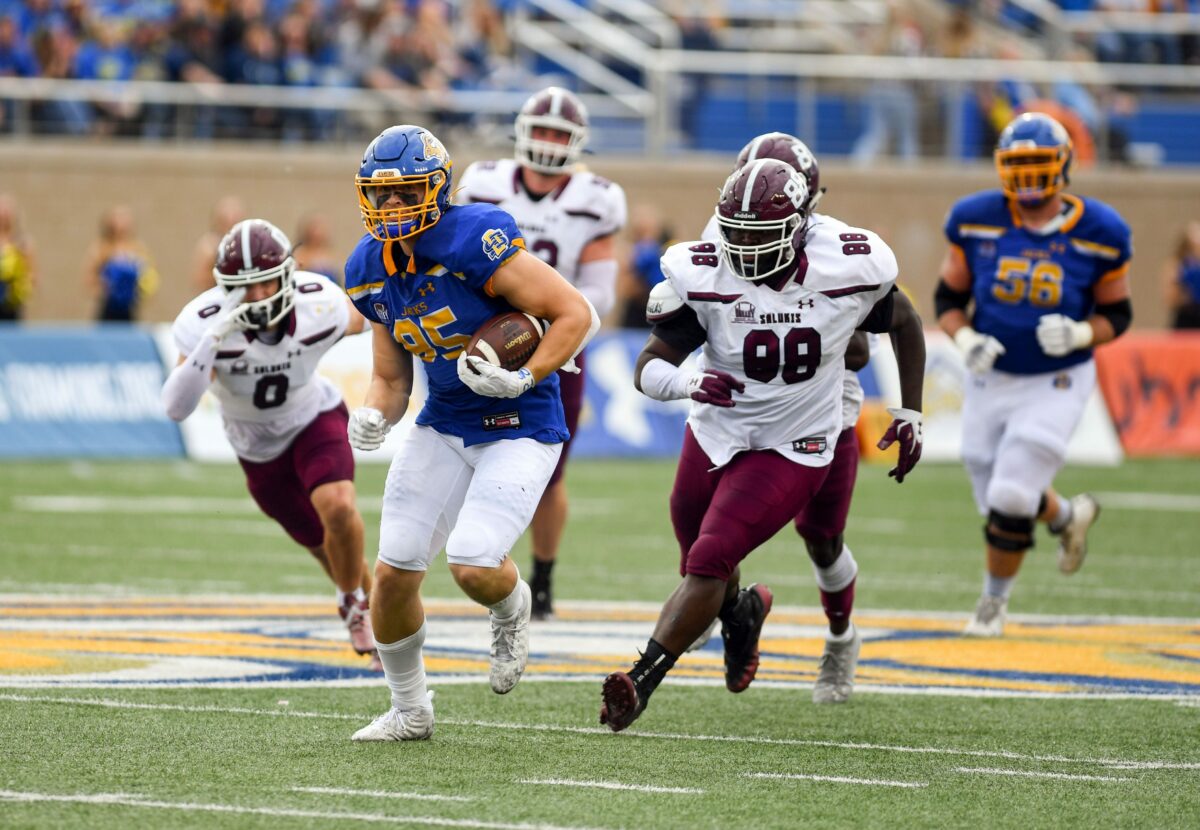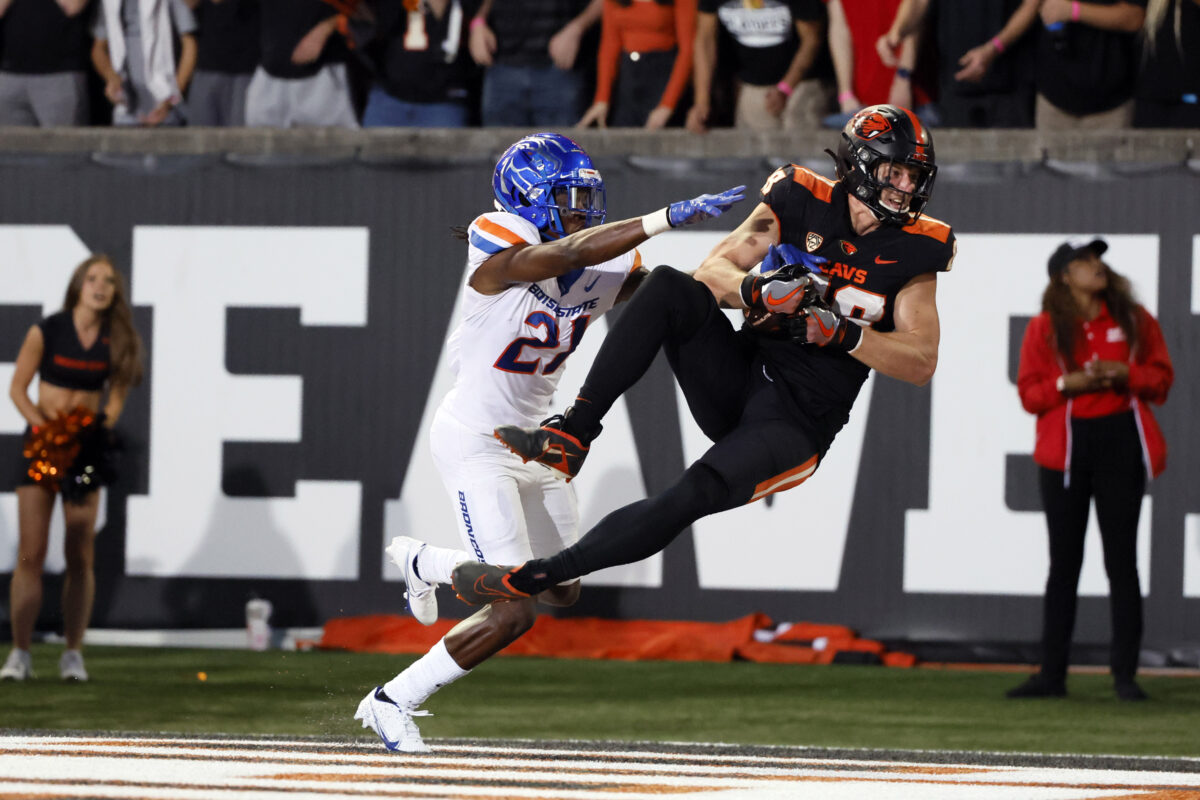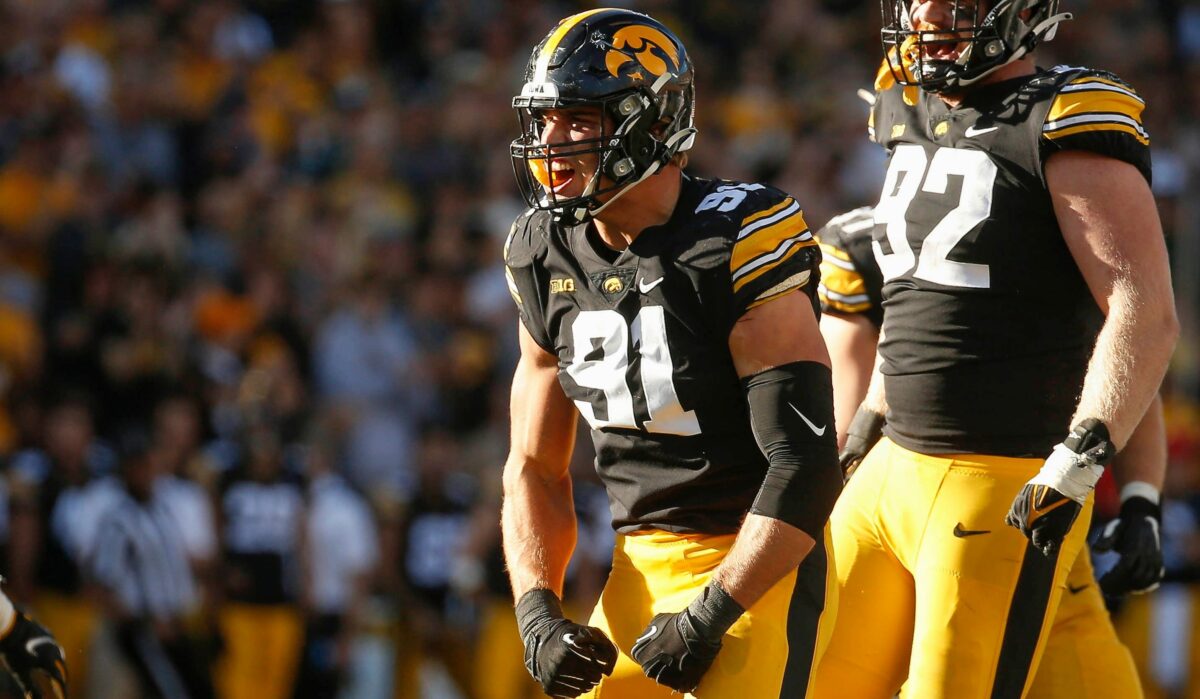Scouting reports from draft experts on tight end Luke Musgrave, the Packers’ second-round pick in the 2023 draft.
The Green Bay Packers added an offensive weapon with the 42nd overall pick in the 2023 draft, selecting Oregon State tight end Luke Musgrave.
Musgrave had his senior season cut short by a knee injury, but he was able to return for the Senior Bowl, where he turned heads with his elite athleticism and pass-catching ability.
Want to learn more about Musgrave, who has a legitimate chance to compete for TE1 duties right away in Green Bay? Here’s what several prominent draft analysts said about Musgrave during the pre-draft process:
Dane Brugler, The Athletic (draft guide): “A two-year starter at Oregon State, Musgrave was a Y tight end in offensive coordinator Brian Lindgren’s run-heavy scheme, lining up both inline and in the slot. After two seasons as a backup behind two future NFL players Noah Togiai (Philadelphia Eagles) and Teagan Quitoriano (Houston Texans), he became a starter as a junior, but his targets were limited in the Beavers’ run-first offense and he missed almost all his senior year because of injury. An impressive size/speed athlete, Musgrave runs like a gazelle (elite high school track numbers for his size), and his lacrosse and skiing backgrounds translate to football with his core strength and hip fluidity as both a pass catcher and blocker. He blocks with outstanding body control and leverage to be a physical edge setter and engage defenders at the second and third levels, although he still needs to improve his sustain skills and steadiness as a pass blocker (only 5.9 percent of his career snaps on offense came in pass protection). Overall, Musgrave must continue to build up his football resume and overall consistency, but he is a high-level athlete with the route running and blocking talent to be a productive starting combo tight end in the NFL. He should be the first-ever Oregon State tight end drafted in the top 100 picks.”
Daniel Jeremiah, NFL.com: “Musgrave is a tall, muscular tight end with elite play speed. Unfortunately, he missed all but two games of the 2022 season due to injury. He’s sudden in his release and is a weapon running down the seam. He pulls away from second-level defenders and can naturally high point the football. He is more of a home run hitter than an option-route player at this point in his development. He is consistent catching balls on his frame, but he struggles to reel in low passes when on the move. After the catch, he has the speed to pull away. He is a willing blocker and can effectively shield/wall off at the point of attack. Overall, Musgrave isn’t polished and he’s missed time, but he has the potential to emerge as the top tight end in the class.”
Lance Zierlein, NFL.com: “Between the abbreviated 2020 season and an injury-shortened 2022 campaign, Musgrave’s snaps have been somewhat limited, but it’s easy to like what he’s put on tape. His route running harkens back to his slalom days with nimble feet and smooth hips helping to generate rhythm and separation in and out of breaks. He needs a little more bulk for combat in the trenches, but he offers what evaluators are looking for in technique, strain and demeanor. Musgrave has starter potential and should gain a coveted slot on draft boards from teams looking to add versatility to their 12 personnel (two tight ends) packages.”
Mike Renner, Pro Football Focus (draft guide): “Musgrave is a tremendous athlete, but his collegiate career has been littered with bad luck that has kept evaluators from seeing his best for any length of time. His four seasons in college included the COVID-19-shortened 2020 season, where he caught 12 passes for 142 yards, and this past season, where a knee injury ended his year after just two games. The start of the 2022 season highlights why NFL teams will like him, though, as he averaged 3.38 yards per route run while totaling 89 and 80 yards in the first two games of the season.
Bleacher Report Scouting Department: “Luke Musgrave is a highly athletic tight end who may need to add some strength before he realizes his full potential. In simple terms, Musgrave is too tall and fast to cover easily. He’s 6’6″ but plays with airy change-of-direction skills and long, explosive strides that allow him to separate in the open field. He excels on deeper routes, such as seam routes, deep overs and corner routes that allow his athletic tools to shine. Moreover, Musgrave has the twitch and route-running chops for a full route tree, even from wide receiver alignments. Musgrave is fairly snappy at the top of his routes and can explode out of them in order to generate separation, a tough skill to find in most players his size. Combine that with his ability to track and reach the ball outside his frame, and you have a receiver who thrives in space. Musgrave is a solid blocker, too. His raw strength is about average, but he brings his game up a tier through great technique. Despite being 6’6″, he does well to find good leverage and play with a sound base under him. Likewise, he plays with smart, active hands and rarely ends up whiffing on his targets. He may not be a people-mover, but he gets the job done reliably. Where Musgrave struggles is with play strength as a pass-catcher. He is prone to getting jammed up at the line of scrimmage or rerouted early in routes. He doesn’t have the raw strength nor the crafty hand usage to combat it right now. Likewise, Musgrave can struggle when battling for position on the ball. He too often concedes positioning and allows defensive backs to get to the ball, disrupting his ability to finish plays in traffic. That’s going to be an issue against bigger, stronger NFL athletes. In all, Musgrave’s height, athletic tools and baseline blocking skills give him everything he needs to be a weapon. He can succeed as a field-stretching tight end who doesn’t have to leave the field on run downs, which gives him access to aggressive play-action concepts to make use of his speed. He will need to add weight and muscle in order to handle himself in traffic and over the middle of the field, however. Hopefully a year or two in an NFL weight training system can do the trick and unlock his potential.”
The Draft Network: “Tight end Luke Musgrave was a consensus three-star recruit and top-five-rated player in the state of Oregon. He spent time in high school at the defensive end and wide receiver positions in addition to tight end. Musgrave was a multi-sport athlete. Along with football, he participated in, lacrosse, ski racing, and track. This provides context to the plus athleticism that Musgrave possesses. NFL football runs through Musgrave’s bloodline. His uncle, Bill Musgrave, is the current offensive coordinator for the Denver Broncos. Also, he played quarterback in the NFL from 1991-1998 for multiple teams. Musgrave brings a big, athletic option in the passing game to an offense. Musgrave is alignment-fluid and versatile. If your offense wants to place him in-line as a traditional Y-tight end or split him into the slot, he can operate both well. As a pass-catcher, Musgrave has secure and reliable hands. He tracks the ball well and attacks it at the highest point. He is an adequate route-runner. He is at his best threatening vertically up the seams or across the field on benders (over route). If unimpeded, Musgrave’s speed can become a problem for linebackers. In the run game, he is a competitive blocker that gives maximum effort. Musgrave is more of a wall-off and seal blocker than a displacer. He does a good job using the defender’s momentum against them to cut them off from the ball carrier. As a result, he sells blocks well on TE leak or delay calls, allowing him to sneak past second and even third-level defenders downfield. Musgrave is a tremendous athlete and should test well this draft season. I do not see an overly explosive player on the field. He gallops and needs free releases to hit that top gear. When faced with physical coverage and resistance, Musgrave struggled to create separation on his routes. He does not play through contact well enough during his route stems. He can be impeded and slowed down if defenders can get their hands on him early in routes. His average play strength shows up in blocking sequences. Musgrave is not a uber-physical blocker—do not expect him to displace defenders. Also, he attempts to engage blocks with high hips and pad level. This limits his overall effectiveness as a man or gap scheme run blocker. Although Musgrave is versatile to align inline or detached, I believe his best reps come when he is in-line. As an NFL tight end, I envision Musgrave as a TE2 early in his career with the potential to develop into a starter. His value in the red zone is enticing. He can operate out of 12-personnel packages with two tight ends that can either use the pass or run game to move the football. Musgrave can stand to improve his play strength and defeat physical coverage quicker since time in the NFL is shorter for quarterbacks.”
33rd Team: “Musgrave has good upper body thickness but is narrow in his lower body. He is a good athlete with good speed and fluid hips. He has a good burst and the ability to stretch the field. He has a good stem at the top of his route to separate from his defender. He can run a variety of routes and has good quickness in and out of his cuts. He has solid hands with good technique catching the ball with his hands away from his body. He shows toughness and solid strength in contested catch situations. As a blocker, he shows good effort and toughness but lacks strength at the point of attack. He is a wall-and-shield type of blocker who just gets in the way rather than blowing his guy off the ball. He has a good ability to block in space and takes good angles.”
[lawrence-related id=93086,93088,93056]



